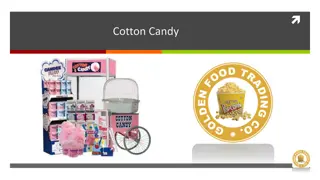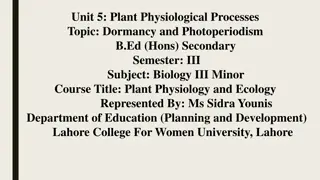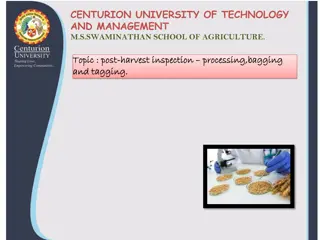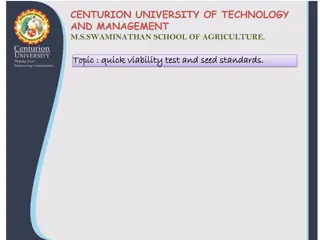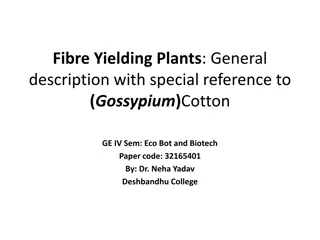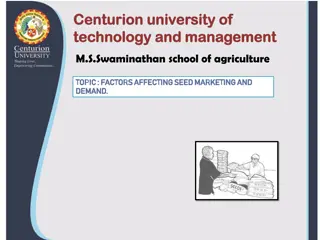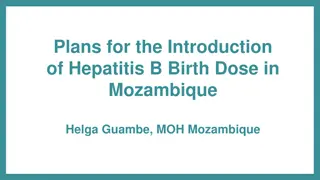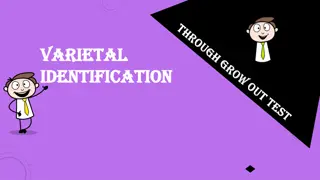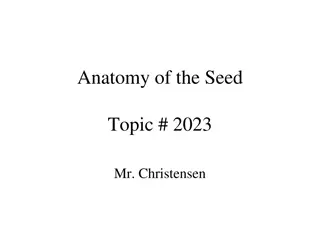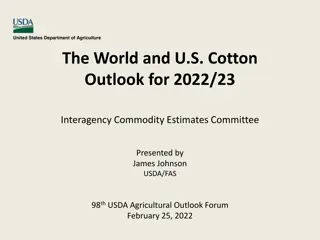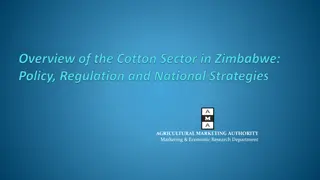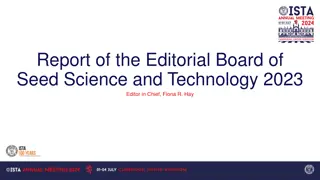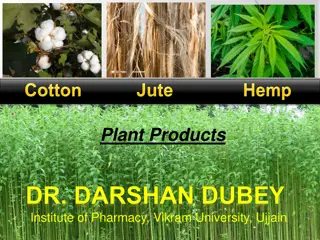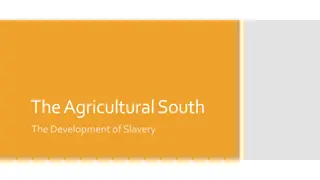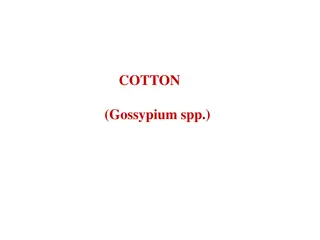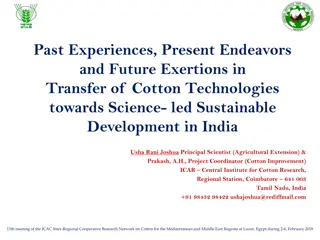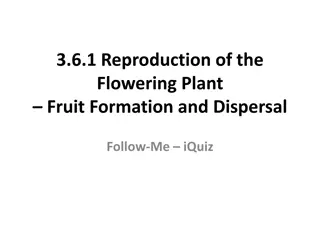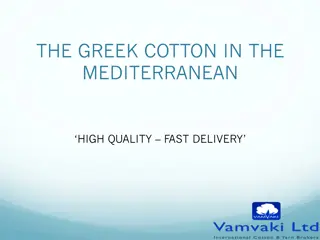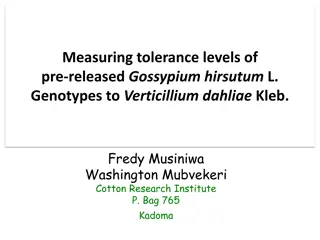Enhancing Cotton Seed Quality for Sustainable Growth in Mozambique
The cotton subsector in Mozambique has significant potential but faces challenges due to the poor quality of seeds. AAM aims to improve cotton seed quality by establishing a seed treatment plant, benefiting farmers and ginners alike. The project, divided into inception and operational phases, promises substantial positive impacts and sustainable growth in the sector over the next decade.
Download Presentation

Please find below an Image/Link to download the presentation.
The content on the website is provided AS IS for your information and personal use only. It may not be sold, licensed, or shared on other websites without obtaining consent from the author.If you encounter any issues during the download, it is possible that the publisher has removed the file from their server.
You are allowed to download the files provided on this website for personal or commercial use, subject to the condition that they are used lawfully. All files are the property of their respective owners.
The content on the website is provided AS IS for your information and personal use only. It may not be sold, licensed, or shared on other websites without obtaining consent from the author.
E N D
Presentation Transcript
Business Plan Presentation Cotton Seed Treatment Plant AAM Associa o Algodoeira de Mo ambique Maputo, July 2020 1
Executive Summary Background The cotton subsector is one of the most organized and impactful subsectors in Mozambique. In the last years an average of 216.000 farmers, produced seed cotton in an area of 152.000 Hectares, with an average yeld of 0.46 TN/HA, wich results in an average year production of 74.000 TN of seed cotton. Despite its great impact, the seed currently in use in the subsector remains degenerate and, therefore, not very productive, either in the field or in the ginneries and an improve in the quality seed can generate a greater impact per USD invested. Objective AAM plans to improve the farmers cotton seed quality by implementing a seed delinting, cleaning, coating and packaging plant. In order to decrease the investment risk, in the inception phase, each Ginnery will purchase individual equipment, at it s own seed capacity need, with co-funding raised by AAM and Technical assistance and training provided to all ginners staff, who will run the small seed plant and field team. With the learnings from the 2 years inception phase in the 3rd year AAM will do the final decision to go for a seed treatment plant in Nampula province that will treat the seeds from all the ginners. Investment The inception phase results in a investment of around 184.000 USD per each 100 Tones/Year of seed need for each Ginnery. The second phase will need an investment of between 1.1 M USD and 4 M USD for a 3.000 Tones/Year of seed need and between 1.8 M USD and 5.7 M USD for a 5.000 Tones/Year of seed need and will promoted by a cooperative created by the AAM ginnery members with possible entries of some subsector partners. Impact The seed treatment plant can have a 10 Years cumulative positive impact of around 95 M USD on farmers, around 445 USD of income increase per farmer. For the Ginners, the seed treatment plant can have a 10 Years cumulative positive impact of around 128 M USD and for IAM the same impact will be around 4.6 M USD. 2
Content 1. Brief analysis of the cotton sector Pag 4 10. Location and facilities Pag 41 2. Short and medium term cotton seed needs 11. Environmental Assessment requirements Pag 45 and availability Pag 8 12. Legal and Legislation requirements Pag 47 3. Brief presentation of the 2030 Alliance Pag 9 13. Marketing-Mix Pag 48 4. Proposed business model according with 14. Investment and operating budget Pag 49 the Alliance 2030 principles Pag 10 15. Financial and Economic model and sustainability Pag 51 5. Strategic Analysis Pag 11 16. Risk Assessment and Mitigation Strategy Pag 54 6. Special Purpose Vehicle Pag 19 17. Impact and sustainability Pag 55 7. Management Model Pag 28 18. Decision Pag 57 8. Technical solution and feasibility Pag 36 19. Implementation plan and schedule Pag 58 9. Operational Model Pag 40 20. Bibliography Pag 59 3
1. Brief analysis of the cotton sector International World Cotton Fiber Production, 2008-2018 Africa s Cotton Fibre Production, ~2011-2016 Cotton Fibre Productivity, 2008-2018 Million Tn India ChinaUnited Pakistan BrazilRest of the Fiber Production ( 000 Tn) 255 212 150 128 102 98 73 58 57 53 49 % of African Production 17 14.1 10 8.5 6.8 6.5 4.9 3.9 3.8 3.5 3.3 Total Country States 2.79 World 4.54 United States Tn/Ha China India Brazil World 4.93 8.03 2.01 1.21 23.5 2008 Burkina Faso Mali Ivort Coast Benin Cameroon Egypt Tanzania Zimbabwe Nigeria Zambia Chad Other Countries (Mozambique) TOTAL 5.19 6.93 2.65 2.16 1.19 4.18 22.3 2009 1.31 1.3 1.25 1.38 1.56 1.46 1.54 1.52 1.58 1.76 1.7 0.52 0.5 0.52 0.51 0.53 0.57 0.51 0.48 0.54 0.52 0.49 0.91 0.87 0.91 0.89 0.99 0.92 0.94 0.86 0.97 0.99 0.91 1.44 1.43 1.4 1.36 1.47 1.55 1.6 1.35 1.63 1.71 1.71 0.79 0.75 0.77 0.78 0.8 0.8 0.77 0.7 0.77 0.81 0.78 2008 2009 2010 2011 2012 2013 2014 2015 2016 2017 2018 5.87 6.6 3.94 1.95 1.96 5.58 25.9 2010 6.24 7.4 3.39 2.31 1.89 6.61 27.9 2011 6.29 7.6 3.77 2 1.31 6.08 27.1 2012 6.77 7 2.81 2.08 1.73 5.78 26.2 2013 6.56 6.6 3.55 2.31 1.56 5.59 26.2 2014 5.75 5.2 2.81 1.54 1.29 4.91 21.5 2015 5.87 4.9 3.74 1.66 1.53 5.4 23.1 2016 268 17.8 6.35 5.89 4.55 1.8 2.01 6.15 26.7 2017 -30 1,502 -1.9 100 6.05 5.72 4.01 1.75 2.31 6.01 25.8 2018 Source: OECD/FAO (2019), OECD-FAO Agricultural Outlook , OECD Agriculture statistics (database), http://dx.doi.org/10.1787/agr-outl-data-en; data from ICAC. Source: OECD/FAO (2019), OECD-FAO Agricultural Outlook , OECD Agriculture statistics (database), http://dx.doi.org/10.1787/agr- outl-data-en. Source: Adapted from USDA, IAM historical Cotton Fiber Consumption, 2008-2018 Cotton Fiber Price, 2008-2018 China India Pakistan Viet Nam BangladeshRest of the Million Tn World 6.81 7.26 7.11 6.57 6.86 7.03 6.93 6.64 6.49 6.59 7.05 9.27 10.19 9.7 8.2 7.9 7.6 7.55 7.6 8 9.2 9.07 3.92 4.3 4.47 4.23 4.76 5.09 5.38 5.3 5.15 5.2 5.25 2.45 2.26 2.17 2.12 2.22 2.47 2.47 2.15 2.15 2.35 2.35 0.27 0.36 0.35 0.41 0.49 0.67 0.88 1.01 1.17 1.53 1.59 1.04 1.09 1.1 0.93 1.25 1.33 1.4 1.53 1.62 1.87 2.02 2008 2009 2010 2011 2012 2013 2014 2015 2016 2017 2018 Source: OECD/FAO (2019), OECD-FAO Agricultural Outlook , OECD Agriculture statistics (database), http://dx.doi.org/10.1787/agr-outl-data-en; historical data from ICAC. Source: OECD/FAO (2019), OECD-FAO Agricultural Outlook , OECD Agriculture statistics (database), http://dx.doi.org/10.1787/agr-outl-data- en; historical data from ICAC. 4
Brief analysis of the cotton sector National Between 2005 and 2018 the maximum planted area in Mozambique was 188,890 hectares in 2012, the minimum planted area was 101,404 hectares in 2016 and the average was 151,920 hectares. The average area per producer was 0.8 Hectares. Between 2005 and 2018 the maximum Tn / Ha yield was 0.975 country average in 2012, the minimum was 0.314 in 2017 and the period average was 0.46 Tn / Ha. Between 2005 and 2018 the maximum production was 184,141 Tn in 2012, the minimum was 35,800 Tn in 2017 and the average was 74,176 Tn. Between 2005 and 2018 the maximum number of producers was 296,000 in 2012, the minimum was 144,864 in 2016 and the average was 216,000 producers. Between 2005 and 2018 the maximum fiber production was 69,974 Tn in 2012, the minimum was 13,616 Tn in 2017 and the average was 27,186 Tn. Between 2005 and 2018 the industrial yield varied between 34% and 38% with an average of 37%. The average FOB export price of the fiber varied between 1000 and 2500 USD / Tn with an average of 1482 USD / Tn. The Smallholder farmers are responsible for 98.98% of cotton production; The province of Nampula is the province with the largest cotton production, followed by Cabo Delgado, Niassa and Tete; 5
Brief analysis of the cotton sector The need for quality seed and the opportunity to get immediate results just by treating the current seed The seed currently in use in the subsector remains degenerate and, therefore, not very productive, either in the field or in the ginneries; The Ginneries provide the vast majority of seeds from the previous harvest to farmers free of charge, leading to the degeneration of varieties The low germination rate of weak seeds results in lower yields, reduced income for farmers and lower levels of productivity across the value chain The seeds supplied to farmers, in addition to not being certified, are not delinted which means that: It is more bulky, more expensive and complicated to transport; Mechanical planting is not possible Farmers need more time/labour in the field to slow down overgrowth of plants per hole and / or make the thinning and hoeing, and ginners have to provide more than ideal seeds to cover waste; 6
Brief analysis of the cotton sector The need for quality seed and the opportunity to get immediate results just by treating the current seed Cotton Seed Delinting and Treatement allows: Carry out the selection of damaged or diseased seeds; Decrease the weight of seeds transported by 25 to 40% (with an impact on logistics costs) and significantly increase the germination rate from 60% to 80%; It decreases the necessary amount of seeds per hole from the current 5 used to 1 to 3; It reduces the amount of labour required by the farmer, mainly in thinning that has an impact in reducing in average 80%, from 5 to 1 Working day, or 6% the total days of labour (67 to 63 working days per hectare); The treatment given to the seed after delinting allows to obtain a seed more resistant to pests and diseases; The impact that delinting has on increasing productivity by Hectare is being studied with cotton experts but is estimated that can increase the productivity between 30 and 40%, so from the actual average of 460Kg/Ha to 640Kg/Ha; Based on approximately 216,000 producers(average 2005-18), with an average area of 0.8 Hectares each, delinting would allow an increase in production of 7,949 Tn of seed cotton a year; Based on the price of 23,000 Meticais paid to the producer per ton of seed cotton, it would mean an increase of 11,080,000 Million USD in the total producers' income per year; An increase of IAM revenues, based on the increase of exported quantities; 7
2. Short and medium term cotton seed needs and availability For 200.000 Ha, in an optimal scenario with a sowing rate of 12 kg / Ha, 2,400 tonnes of certified seed would be required. Given the current rate of 20 to 25Kg/Ha, the need increases to 4,000 to 5,000 tonnes of seed in the short-medium term: Source: AAM, 2019 8
3. Brief presentation of the 2030 Alliance In 2018, AAM defined a Vision called the 2030 Alliance, with a set of strategic objectives to be achieved in the sector by 2030, namely: A strong and unified industry, through: A seed production program, Databases and information, Production model and production training strategy, Input pricing strategy and coordination, Procurement (Procurement of global suppliers and individual acquisitions), Fibre Marketing (joint promotion and individual sale), Coordination in the sale of cottonseed, Value addition; Develop a national brand and promote it aggressively and effectively; Commitment to quality, sustainability and the environment; Commitment to innovation and technology; Commitment to empower young people and women; Commitment to rural development and rotation or complementarity with food crops; Market Position: Position in the top 5% of medium-length fibre (which represents about 75% of the market), Consistently reach 100,000 Tons per year, Quality. Type 2, 1-1 / 8, Main differentiating factors: Development and sustainability of the sector in Africa, Professional and standardized image; Promotion of the textile industry; Strategic partnerships: Technical, Development (NGO's, etc.), Financial (NGO's, Cooperations, Development Funds, etc.), R&D (Academy, etc.), Governance (Similar international associations, etc.), Certification, information and data (FAO, WFP, United Nations, etc.) 9
4. Proposed business model according with the Alliance 2030 principles Contribute of the business model to achieve the 2030 Alliance vision for the industry: Strong and united industry The Cotton Seed Treatment Plant Business Model is in accordance with this Alliance 2030 principle as it will be promoted by all the ginneries together for a common development of the subsector, to improve the seed quality and with positive impacts in seedcotton and fibre production. Commitments Quality, sustainability, and environment The Business Model contributes to the quality of seed, seedcotton and fibre, and is economic, social an environmental sustainable; Innovation and technology The Delinting and cotton seed treatment plant is an innovation in the country and it brings new technology to the national subsector; Empower Youth and Women The Seed Treatment Plant will promote youth and women in the recruitment processes and the higher yields will generate a potential higher income and be more attractive for Youth; Rural Development The Seed Treatment Plant will have a positive impact in rural development, creating new jobs and improving the smallholder farmers income and livelihood; 10
5. Strategic Analysis SWOT Analysis Strengths Favourable agro-ecological conditions for cotton production, especially in the centre and north of the country; National Tradition in cotton production and an already high and growing number of small-scale producers (depending on the years, it involves between 200 and 250 thousand small-scale producers, with the number of independent producers growing slowly; Concession model encourages private investment and the strengthening of contract farming; Existence of strong anchor agribusiness players along the segments of the value chain, being one of the most integrated, after tobacco and poultry; With IAM, CIMSAN-IIAM, AAM and FONPA, the subsector is one the best organized sector; Ginneries with good inter-business relationships and interested in cooperating to improve the subsector; Existence of pre-season reference prices that allow managing expectations; Great impact of the sub-sector on the national economy, both in terms of income in small producers, as well as in the value of exports, as well as in direct and indirect jobs connected to concessionaires; Seed Research and Multiplication Initiatives already being implemented by CIMSAN - IIAM; Existence of initiatives in Mozambique aimed at training cotton producers using sustainable agricultural practices and improving cotton productivity and quality (Cotton Made in Africa and Better Cotton Initiative). 3 of the ginners (OLAM, SANAM and SAN-JFS) are currently partners of Better Cotton Initiative 3 ginneries /two invested in 2019) already using cotton seed to process edible oil and cake adding value in country and reducing high dependence on fibre market. 11
Strategic Analysis SWOT Analysis Weaknesses The vast majority of the seeds supplied to small producers are from the previous harvest, leading to the degeneration of local varieties, low germination power of the seeds that result in lower yields, reduced income for farmers and lower levels of productivity across the value chain. The non-delinting of the seed delivered to the producers makes it more bulky, increases its transport cost, makes mechanical planting impossible, makes seed separation difficult, increases the amount of labour required for the crop and increases the quantity of seed to be delivered to the products by the concessionaires; Fertilizer not yet included in the input package; Need for more research and investment by seed companies, working with CIMPSAN, in the production of basic seed adapted to the country; Very low agricultural productivity makes the crop less attractive to producers Harvest and post-harvest practices cause high levels of losses by small-scale producers Offer of public and private extension services still deficient and unsustainable Maximum installed ginning capacity (250,000 TN) used only by an average of 30% in recent years; Low level of national processing of cottonseed and fibre for other by-products Current ginning rate of 38% below the potential of 42% in other African countries; 12
Strategic Analysis SWOT Analysis Opportunities Current high demand for cotton seed in the country, with estimated quantities between 4,500 to 5,000 TN per year in the coming years; Potential to delint and treat the seeds of previous crops before deliver them to the producers with the consequent high benefits; With the renewal of the concession regime, investors will increase investment in the value chain, and IAM is promoting the capture of more private investment (in concessions, but also downstream in textiles and clothing, with great interest from investors Asian) Potential to increase the number of independent producers; Potential to leverage the existing infrastructure, knowledge, context; Potential to increase productivity with better monitoring and effort by producers, verified by 10-15 times higher productivity among producers with the same inputs and production conditions; Existence of a site (With Warehouse, security, close access to utilities) provided by SANAM for provisional installation of the Seed Treatment Plant; Availability of IAM to allow installation of the Plant in a land close to CIMSAN seed multiplication premises Worldwide demand for cotton fibre growing, mainly in Asian countries; Donors and impact funding institutions available to finance with matching grants and other attractive finance products the investment in the Seed Treatment plant and farmers trainings to adopt the new seeds. 13
Strategic Analysis SWOT Analysis Threats Cotton fibre market prices volatility and continuation of last to years trend to decrease New crop diseases and pests that are difficult to control / manage due to monoculture and climate change; Short time for seed treatment, which mediates between ginning and the next planting season, requires very high coordination between ginners; Locations of the concessions very dispersed, which hinders the logistics of collecting the seed and delivering it after treatment; Delinting technology requires very high investment and management skills; Continuation of Insecurity conditions (political conflicts and terrorism groups implantation) The image of the cotton sector in Mozambique damaged by low performance and disinvestment of some ginners. 14
Strategic Analysis PESTAL Analysis Political Factors SeedCotton seen as a strategic subsector by the Government of Mozambique in several of its strategic documents such as PODA (Agricultural Operational Development Plan) and the Cotton Value Chain Revitalization Program itself; Existence of a Public Institute with a specific mandate to promote increased production, productivity, competitiveness and sustainability in the Cotton value chain (IAM) Existence of efforts by CIMSAN-IIAM (Institute of Agricultural Research of Mozambique) in the investigation and multiplication of Cotton seeds Economic Factors Great dependence on the MZM / USD exchange rate for the sector to be competitive worldwide, taking into account that practically 100% of the cotton fibre produced is exported; Existence of a 3.5% fibre transaction fee collected by IAM Very High harbour tariffs, especially in Nacala, compared to the main harbours in the region; 50% Agricultural Diesel Incentive Rate not applicable to Contracted Farmers Support Activities; Long VAT refund period from the Government to the Ginneries; 32% IRPC is one of the highest in the region, despite having had a 10% subsidy rate in recent past years that has not been renewed; Non-intrusive inspection (Kudumba) that works as an export fee valued at around 50 USD for each 40-ft container; Electricity cost is one of the highest's in the region and have been increasing significantly in recent years by EDM. In 2018, the Mozambican average tariff was 8.7 USc/kWh comparing with 2.22 in Angola, 6.33 in Zambia or 7.15 in South Africa 15
Strategic Analysis PESTAL Analysis Social Factors Great impact of the subsector on the income of around 200,000 small-scale producers. As an example, in 2018 the total producers received around 23 Million USD with the cotton production sales; The subsector provided inputs on credit to small-scale producers of close to 5 Million usd, and 25-30% wasn t repaid (the maximum losses from long time); Large number of direct and indirect jobs in the sub-sector. Technological Factors Existence of seed varieties (Albar SZ 9314 e QM 302, Flash, Edessa and BA 440) that enable higher yields of seed cotton and a higher Fibre GOT rate compared to those most used by small producers. Greater presence of seed multiplication companies, some interested in the certified seed multiplication business Possibility of delinting the seeds of the previous harvest through the use of diluted sulphuric acid in existing technologies in India, China and Greece, even before beginning to have certified seed (C1 and C2). Recent installation of some textile production units in the country, both artisanal project (ongoing partnership between Ethiopy and GoM, implemented by Technoserve and SAN-JFS) and industrial (Riopele in South and another in Nampula) ; Little or almost non-existent industrially use in the country for processing cotton by-products such as soap, candles, hospital cotton, paper, cosmetics, fertilizers, animal feed, among others; Some ginners already invested in cotton seed processing for edible oil and cake market purposes adding value to the seed cotton in country (SanOil from Sanam) 16
Strategic Analysis PESTAL Analysis Environmental Factors Existence of initiatives in Mozambique aimed at training cotton producers using sustainable agricultural practices, as Cotton Made in Africa and Better Cotton Intiative, which are implementing partners such as OLAM, SANAM and SAN / JFS. Existence of delinting technologies with reduced environmental impact, such as diluted acid delinting. Delinting process optimizes logistics processes (reduces diesel consumption costs and costs associated with transport and logistics), decreasing the volume of seed with no quality to be transported to the producer. Legal Factors Cotton Subsector regulated by the Cotton Regulation Decree 37/2015 from 31st December, 2015; According to the Cotton Regulation, the Minister of Agriculture defines and updates development and marketing areas of cotton that are awarded to development agents, through a specific contract. IAM Cotton Institute of Mozambique is the public institution that coordinates the activities of promotion, trade and processing of cotton and other crops for textile purposes Production, processing, distribution and import of seeds regulated by the Seed Regulation Decree 12/2013 from 10th April, 2013 17
Strategic Analysis Strategic Goals, Vision and Mission Statement Strategic Goals 100% of the cotton seed used by producers to be delinted from 2021; Achieve in 2022 a rate of 100% of cotton seeds used by producers to be certified seeds; Contribute to the number of cotton producers to stabilize at 250,000 producers in the coming years; Contribute to increasing the number of medium size producers to at least 20% of the total producers, also increasing by 2024 their average area from the current 3 to 6 hectares and their average productivity from the current 1000 to 1600 Kg / Ha using mechanization; Contribute for small seed cotton producers to increase by 2024 the average area in which they produce cotton from the current 0.8 to 1.2 Hectares and the average productivity from the current past average 460 to 800 Kg / Ha; Contribute to increasing the ginning rate (Fibre GOT) from the current 38 to 42%; Vision: Delinted, treated and certified seed available for all! Mission Statement of the SPV: To implement seed delinting and treatment solutions, in practical, innovative and affordable terms for all farmers, bringing the industry together. 18
6. Special Purpose Vehicle Legal Entity Option Pros & Cons Possible Options 1. AAM owns the Seed Treatment Plant and manages it directly; 2. AAM is the owner, but outsources the management to a private entity, or to a new entity with members / partners to be defined 3. AAM creates a new entity, with 2 possible statutes: 3.1 Cooperative A. The Cooperative owns and manages directly with own team; B. The Cooperative owns and outsources the management; 3.2 Private company A. The Company owns and manages directly with own team; B. The Company owns and outsources the management; 4. IAM owns and outsources the management to AAM, having a board where IAM and FONPA as seats; 19
Special Purpose Vehicle Legal Entity Option Pros & Cons Owner AAM New Cooperative 5 Members Minimum Required New Private Company Existing entity with a past record The share capital does determine management or decision-making Possibility to include only the insterested AAM members as the cooperative members The main objective of a cooperative is to provide services to members and the cotton seed treatment is exactly that The share capital does not necessarily determine management or decision-making, but it can do so Possibility to include only the insterested AAM members as the cooperative members Proportional distribution of profits with the economic participation of Members Easier to obtain financing in relation to associations and related to its lower impact on communities that cooperatives has some disadvantages comparing with cooperatives regarding donnors Proportional distribution of profits with the economic participation of Members Avoids the taxation of cooperative acts, that is, the acts practiced between the cooperative and its members and between them and the cooperative to achieve its objectives Main Advantages Easier to obtain financing in relation to associations and related to its larger impact on communities that companies has some advantages comparing with companies regarding donnors More adequate to have a large number of shareholders, comparing with private company More flexible shareholders entry and exit process Possibility that not all members want to own the plant The large number of shareholders always hinders the decision- making process Does not avoid the taxation of the acts practiced between the company and its shareholders and between them and the company to achieve its objectives Difficulty in obtaining financing through the legal form of association Industrial activity not part of AAM's mission statetment Does not allow the liability of the members according to their capital or economic contribution More complex shareholders entry and exit process Main Disadvantages 20
Special Purpose Vehicle Legal Entity Management Option Pros & Cons Management Internal Team Outsourced Increases owner control over productive activity Increased Efficiency Main Advantages Large number of members and with different acitivities will hinder the management decision-making Decreases owner control over productive activity Main Disadvantages Lack of focus of the Ginners Managers in their core business More Expensive 21
Special Purpose Vehicle Cooperative benefits detail A Cooperative fits the best for the purpose of the Seed Treatment Plant because: The objective of the legal entity to be created is essentially to provide services to the ginners, members of AAM, through the treatment of their seeds; The ginners are, at the same time, the main interested in promoting investment in the Factory and in the provision of services that it will provide; There is a minimum number of 5 ginneries interested in being members of the entity that promotes the investment in the Cotton Processing Plant, necessary for the constitution of a cooperative; Allows and facilitates the inclusion of a large number of members in the legal entity and their democratic participation in the entity's decisions; Possibility to define in the cooperative's statutes that the capital shares and the number of votes of each member are proportional to the operations carried out with the cooperative up to a maximum of proportion of 1/7; Possibility that in the future the cooperative may enter into projects with entities in the case of consortium, association contracts in participation, joint ventures, such as, for example, seed companies, among others; Possibility to return profits available to members in proportion to their activities and services; It allows values such as solidarity, democracy, freedom and equity to be respected; It facilitates the access to grants from donors; It as Income taxes (IRPC) exemption of 50%. 22
Special Purpose Vehicle Players & Stakeholders Members of the SPV options and pros and cons: Option 1 - AAM - All the actual and future ginners Option 2: AAM and FOMPA (business interest) Option 3: AAM, FOMPA and IAM / IAM and IIAM Options 2 or 3 with possibility to new entries in the future, as Seed Companies The different institutions playing a role in the subsector will be present and represent their interests for a common benefict Options All the shareholders will have the same interests The both sides will be present and represent their interests, for a common benefict The different institutions playing a role in the subsector will be present and represent their interests for a common benefict Few shareholders, more flexible decision making The ginners and FOMPA can have different capital shares in the cooperative Each entitity can have different capital shares in the cooperative Each entitity can have different capital shares in the cooperative Pros More appealing for grants fund raising More appealing for grants fund raising It allows that in the future seed companies be attracted to the sector The cotton farmers will not share their opinions and proposals and don t fill part of the process Seed Pricing can be complex More Shareholders with different interests, can turn in more complex decision making, More Shareholders with different interests, can turn in more complex decision making Cons Less appealing for grants fund raising Conflicts of interest with seed companies 23
Special Purpose Vehicle General Governance Model Governance Structure Non-executive board Option 1: all members of AAM represented; Option 2: independent of SPV s members options, consider also FONPA, or FONPA and IAM representation Board Meetings: quarterly meetings; monthly skypes) Professional executive team: Option 1 Hired (some in full time, the others seasonal); Option 2 - Outsourcing External Audit (financial, procurement and management) 24
Special Purpose Vehicle Bylaws Main Principles of SPV Bylaws List of at least 5 initial members Article 1: Cooperative Legal name To be Defined; Article 2: Headquarters address To be Defined Article 3: Coop Objective: To improve the Cotton Seed Quality by Seed Delinting, Treatment and Test; Article 4: Share Capital Coop Total Share Capital To be Defined Coop Members minimum Share Capital To be Defined Article 5: Definition of who can be a Coop member (according to the options of slide 6.2) New members admission process; Members dismissal process; Article 6: Coop members rights Participation in General Meetings Elect and be elected to membership of the Coop Management Team; Participate in all activities that are the object of the cooperative; Resign from the cooperative at any time. Received the delivered seed after treatment; 25
Special Purpose Vehicle Bylaws Main Principles of SPV Bylaws - Continuation Article 7: Coop members Duties Subscribing and paying the capital shares; Deliver the cotton seed for treatment as defined in the pre-season of each year; Do not carry out competitive activities with those carried out by the cooperative; Ensuring loyalty to the cooperative; Article 8: Coop Corporate Bodies a) The General Meeting; b) The Management Team; c) The Fiscal Council. Article 9: Coop Corporate Bodies election process and term of office 26
Special Purpose Vehicle Accounting & Auditing Requirements Accounting Regime Tax Obligations; VAT Normal Regime IRPC Organized Accounting Income Taxes exemption (TBC) IRPS INSS Accounting Services; External Services Supplied Internal responsible; Administrative Responsible Auditing Requirements Internal Auditing Procedures, responsible and responsibilities External Auditing Procedures, schedule and responsible Transparency Annual Report and Auditing presentation to Cooperative members; Annual Operational and Financial Plan presentation to Cooperative members; 27
7. Management Model Management Body Managing body structure 1 Plant Manager + One Supervisor for the 2nd Shift with 2 Administrative Support Staff (1+1 per Shift) Management Analysis and Decisions by the Plant Manager in team Managing body members profile 1 Plant Manager, with good experience in Cotton Seed Diluted Acid Delinting and treatment industrial process management; Term of Office 2 Years with possible extension Responsibilities Plant Management; Technical Staff Management; Administrative Support staff management; Report to Board; 28
Management Model Organizational chart and staff Definition of internal different areas Non-Executive Board Plant Management (1 Manager + 1 Supervisor) Administrative Support Finance & Administrative; Logistics; Technical Staff Electrical Engineer; Mechanical Engineer; Plant Operators: Feeding Section, Acid Section, Seed Treatment Section, Packaging Section; Seed Technologist; Forklift Operator; Non-Technical Staff Warehouse Staff Maintenance Assistants Cleaning Employees 29
Management Model Organizational chart and staff Definition of internal areas organization Plant Management reports to Non-executive Board; Plant Management is responsible for the work organization and supervision of the administrative support area and technical staff; Administrative Support is responsible for work organization and supervision of the non-technical staff and management of staff from service providers (accounting, security, others); Logistics: The Logistic will be responsible to coordinate with the ginners their seed annual supply plan to the treatment plant, update the plans during the year, develop and update with the ginners the distribution plan for the treated seed per ginner. 30
Management Model Organizational chart and staff Needed staff per level and per area EMKAT Shandong Swan Position Plant Manager Plant Supervisor Administrative Support Logistic Manager Electrical Engineer Mechanical Engineer Seed Technologist Maintence Assistants Forklift Operator Wharehouse Staff Cleaning Employees Total # Employees 1 1 2 1 2 2 2 6 2 8 4 31 Month Salary Number of months Annual Cost 5,000.00 12 2,500.00 12 350 12 2,500.00 12 750 12 750 12 500 6 200 6 300 6 120 6 120 6 Position Plant Manager Plant Supervisor Administrative Support Logistic Manager Electrical Engineer Mechanical Engineer Seed Technologist Feeding Section Forklift Operator Acid Section Worker Neutralization and coating section worker Package Section worker Wharehouse Staff Cleaning Employees Total # Employees Month Salary Number of months Annual Cost 1 5,000.00 1 2,500.00 2 350 1 2,500.00 2 750 2 750 2 500 4 200 2 300 2 200 60,000.00 30,000.00 8,400.00 30,000.00 18,000.00 18,000.00 6,000.00 7,200.00 3,600.00 5,760.00 2,880.00 189,840.00 12 12 12 12 12 12 6 6 6 6 60,000.00 30,000.00 8,400.00 30,000.00 18,000.00 18,000.00 6,000.00 4,800.00 3,600.00 2,400.00 2 4 4 4 33 200 200 120 120 6 6 6 6 2,400.00 4,800.00 2,880.00 2,880.00 194,160.00 31
Management Model Organizational chart and staff Global organizational chart Non-Executive Board Plant Manager Plant Supervisor Technical Staff Administrative Support & Logistics Non-Technical Staff Staff from Service Providers 32
Management Model Recruitment and procurement policy Recruitment philosophy National and Local staff priority when complies with the requirements; No discrimination of any kind; Prioritize experience in the management, technical staff and logistics; For the plant managers, prioritize the indication or recommendation from the equipment's supplier for someone who managed some similar equipment's in other country or someone directly from the supplier; Recruitment procedures Responsible Plant Managers: Recruitment Professional Services with final approval from the non executive board; Administrative Support: Recruitment Professional Services with final approval from Plant Manager Technical and Non-Technical Staff: Recruitment Professional Services with final approval from Plant Manager Source-of-hire Plant Manager: 1st option: Equipment Supplier indication, 2nd Option: Regional Procurement Others: National Recruitment Services 33
Management Model Recruitment and procurement policy Procurement Procurement Philosophy Administrative and Finance responsible must prepare an internal procedures guide, after consultation with logistic and technical responsible, in the short- term to be approved by Plant Manager and Presented to Non-Executive Board; Competitive Biddings (Publication in National Newspaper and bid analysis; Procurement procedures (to be detailed in the Internal procedures guide) Responsible Administrative Support Staff with Plant Manager Approval Expenditure Limits 0>5.000 USD : 3 Proposals Tenders 5.000 USD > Max : Public Tender 34
Management Model Operational Criteria & Requirements Operational Criteria Functional parameters Time frames Seed Reception June and July Seed Delinting and Treatment August and September Delinted and Treated Seed Deliver September and October Weights 5 and 25KG Seed Bags Operational Requirements Concept of operations Diluted Acid Delinting, Treatment, Packaging Operational functions/capabilities 10TN/Hour 35
8. Technical solution and feasibility Delinting process type Possible Delinting Solutions Mechanical delinting: It is a traditional process of delinting using brushes and is common in the oil industries but not for seed treatment. Mechanical delinting is not suitable for seed classification or for removing low density seeds, as the process does not remove all of the seed fibres. Dry Gas Delinting with Hydrochloride Gas: The Hydrochloride Gas delinting process is used mainly in arid areas, where the moisture content of the cotton seed is less than 9% and the low humidity reduces the corrosion of equipment and installations. Hydrochloric gas is used to degrade fibres so that they can be removed from the seed by frictional forces. The Hydrochloride gas delinting process requires very sophisticated equipment, rigorous monitoring and strict control of the various operations for effective removal without damaging the seed. The main causes of seed damage in this process are very high reaction temperatures and gas concentration, very long reaction time and "excessive" neutralization with ammonia. Disintegration with poorly controlled and managed hydrochloride gas can cause a drastic reduction in seed germination and vigor. Wet Acid Delinting: The wet sulphuric acid delinting system is preferred in wet areas. The process is relatively simple and does not require sophisticated equipment. The cotton seeds are fed into a reactor trough or tank and mixed with concentrated sulphuric acid. The main problem with this method is the high cost of sulphuric acid and the high negative environmental impact caused by the disposal of acid and washing water after the process. Diluted Acid Delinting: The advantages of this process in relation to Wet-acid are a great reduction in the amount of sulphuric acid needed, having a great impact in reducing the cost of the process and still in the elimination of the effluent produced in wet-acid delinting, eliminating the existing environmental cost in the wet-acid process. For these reasons, the Diluted Sulphuric Acid method has been the most used worldwide for the process of delinting cotton seeds for seed treatment, resulting in a lower processing cost and reduced environmental impacts of the operation. 36
Technical solution and feasibility Delinting process type Type of Seed Treatment in the Plant Diluted Sulfuric Acid Delinting; Delinted Seed Drying; Seed Separation and cleaning; Chemical Seed Treatment - Neutralization; Seed Testing; Seed Packaging; Equipment Proposals Analysis Annexed Excel Document Equipment Proposal Analysis 37
Technical solution and feasibility Equipment Capacity Equipment capacity 5 or 10TN/H To justify the defined capacity Haverage area planted (ha) 1 1 1 1 1 Total Nr.Hours for processing 960 720 720 720 720 Cotton Seed Need (output)(MT) 5,000 4,500 4,250 4,000 3,750 Cotton Seed Need (input)(MT) 7,692 6,923 6,538 6,154 5,769 Nr. Hours per Shift per week 48 48 48 48 48 Nr. Weeks for processing 10 10 10 10 10 MTH capacity need 8 9.6 9.1 8.5 8 Nr. Seed Clean out coeficient 65% 65% 65% 65% 65% Year/Indicator Year 1 Year 2 Year 3 Year 4 Year 5 Farmers 250,000 250,000 250,000 250,000 250,000 per/ha(Kgs) 20 18 17 16 15 Nr.Shifts 2 1.5 1.5 1.5 1.5 Logical input and output capacity Output/Input Seed Rate: 65% 38
Technical solution and feasibility Packing Solution and additional relevant components Packing Sizes and Shapes 5 to 25 Kg or 0.5Kg to 5 Kg packing lines (2 Options) Paper Bag or Woven Bag Packaging method Delivering Belt Conveyor Packaging Additional relevant components Seeds Washing Seeds drying Acid Storage Chilled Storage for parent seed 39
9. Operational model Key operational rules Seed Processing Annual Plans The ginners deliver to the seed treatment plant a draft Seed Quantity and quality plan till January of each year; The ginners update the Plan in April each year (the same time that they meet with the AAM and other subsector stakeholders to set the minimum cotton price) Seed processing scheduling rules June and July The Ginners deliver the seed to the Plant; August and September The seed is delinted, treated and packed; September and October The Ginners collect the seeds at the Plant; Members seed processing equality rules The seed is treated and distributed in First-come, First Served basis; The Members should report their expected quantities in the beginning of each season; All the ginners will use their own transport to deliver and pick up the seed before and after the treatment; 40
10. Location & Facilities Location Site location options pros & cons SANAM site Rent - Located in Namialo, SANAM has some warehouses available in its Industrial Park that can be used for the installation of the Cotton Seed Treatment Factory. The site has access to grid power, good access roads (Estrada Nacional Nampula-Nacala), very close to the railway and the possibility of having water supply through a borehole, and the water table is estimated to be 45 to 50 meters deep. The need investment in this option will be lower since there will be only need to rebuild and improve one warehouse; CIMSAN site - Green Field Project - Located in Namialo, CIMSAN has a land of 20,000 m2 on which it has space available for the construction of a new infrastructure for the Cotton Seed Treatment Plant. The site has access to grid power, good access roads (Estrada Nacional Nampula-Nacala), very close to the railway and the possibility of having water supply through a borehole. The need investment in this option will be higher since there will be need to build a new infrastructure; Nacala Industrial Park or Other Site to be identified Rent or Green Field Project- If none of the 2 options prove to be viable, a third option will be the installation of the Seed Treatment Factory in the Industrial Parks of Nampula or Nacala. In this case, the need investment will be lower since it will mean a monthly rent and maybe some initial investment for improved/adaptation of the building; Government Building (IAM, ICM, other): Renting with a cost or no cost (depending on ownership - e.g. PPP, governance model) Guro - Improve/replace IAM s seed treatment plant already installed. A major disadvantage is the additional logistical cost for all ginners, to be higher than the cost of hiring or building a greenfield project, as it is demonstrated in the scenarios that rent and construction have a low weight on the cost of services. Ginnery Plants For the inception phase, each Ginnery will use its own plant to process its seeds with small capacity equipment. 41
Location & Facilities Location To analysis the different expected costs from rent a Warehouse and to build a new one/Rebuild we will use the follow assumptions: Plant Building Cost Cost per m2 = 300 USD Utilities Installation = 250.000 USD EMKAT 5TN/H = 1.090.000 USD Total EMKAT 10TN/H = 1.090.000 USD Total Shandong 5TN/H = 406.000 USD Total Shandong 10TN/H = 562.000 USD Total Building Rental Building Rehabilitation Works = 75 USD/ m2 Utilities Installation = 100.000 USD EMKAT 5TN/H = 310.000 USD Total (Building Rehabilitation Works + Utilities Installation ) EMKAT 10TN/H = 310.000 USD Total Shandong 5TN/H = 139.000 USD Total Shandong 10TN/H = 178.000 USD Total Rent: 3 USD / M2 EMKAT 5TN/H = 8.400 USD/Month EMKAT 10TN/H = 8.400 USD/Month Shandong 5TN/H = 1.560 USD/Month Shandong 10TN/H = 3.120 USD/Month 42
Location & Facilities Requirements Location in relation to suppliers and customers Nampula/Nacala Required area EMKAT 5TN/H: 2.800 M2 EMKAT 10TN/H: 2.800 M2 Shandong 5TN/H: 520 M2 Shandong 10TN/H: 1.040 M2 Storage area Around 450m3 of Final product storage capacity Sulphuric Acid Storage Tanks include in the plant equipment Water access Maximum Consumption for productive activities: Between 60 and 1500 m3 need per year (EMKAT/Shandong Swan) EMKAT: 60 M3 per year for 5Tn/H; 94 M3 for 10Tn/H Shandong: 984 M3 per year for 5Tn/H; 1500 M3 for 10Tn/H Power supply access Maximum Consumption for productive activities: Between 415.000 and 830.000 Kwat/Year (Shandong Swan/EMKAT) EMKAT: 5 TN/H: 522 HP/ 389 KW per hour 10 TN/H: 1044 HP/ 778 KW per hour Shandong Stable industrial power supply, 380V,50HZ 5TN/H: 250.9 KW per hour 10 TN/H: 516.8 KW per hour Sewage System 43
Location & Facilities Layout project EMKAT 10 TN/H Shandong Swan 10 TN/H 44
11. Environmental assessment requirements Definition of Environmental Assessment grade that applies (B or C): The Seed Treatment Plant does not fall into category A as long as its location is not in protected areas or areas with specific conditions; The activity Processing or seed treatment is not included as an example in any of the Categories B or C. Although delinting with diluted sulphuric acid is considered a delinting method without major environmental impacts, due to the use of sulphuric acid in the process of treatment of cotton seeds it appears that it will be included in Category B, to be confirmed after the submission of the Process Instruction at MITADER. Requirement for EIA (Environmental impact study) or EAS (Simplified Environmental Study) Step 1: Registration or Instruction of the Process through the Provincial Directorate of Land, Environment and Rural Development (DPTADER) of Nampula using the attached form. If the feedback of DPTADER is into category B, there is a need for a Simplified Environmental Study (EAS). If the feedback of DPTADER is into category C, the project is exempt from EIA or EAS; Timeline Pre-evaluation feedback: up to 8 working days; Terms of reference for EAS feedback: up to 15 working days Simplified environmental study feedback: up to 30 working days; Issuance of the environmental license: 8 working days, after payment of the fees due; Applicable fees Category B: 0.1% of the total investment amount. Category C: 0.01% of the total investment amount. 45
Environmental assessment requirements Grade (1- 5) Grade (1-5) Risk Variables EMKAT SWAN The burnt lint is neutralized and becomes alkaline and thus poses no threat to environment even if delivered to atmosphere. The system doesn t have important impact on Solid waste and their disposal. There is a special cleaning system of the returning liquids to avoid that these will be discharged to the ground water. This resulted to a reduction in pollution by 95% as the diluted mix remains clean. The system doesn t have important impact on Solid waste and their disposal. Possible increase of soil erosion by the wind or water, on the site Waste treatment system (solid residuals) 5 3 It needs some water to clean the machine while processing season completed to stop the acid delinting line or a long breakdown time for the acid delinting line. The water that used to clean the centrifuguer, neutralizing and coating machine can not be discharged to land, which need to discharged to a sedimentation basin. Emission of bad odours in the surrounding area. Possible emissions in the atmosphere or downgrading of the atmosphere quality. Increase of the existent noise level. Water treatment system 4 3 No Major emissions in the atmosphere or downgrading of the atmosphere quality. No bad odours. No changes in the movement of air, humidity or temperature or any kind of climatic change locally or to a wider extent The cyclones receiving the hydrolysed fibre are only 95% efficient. That means 5% is wasted in the air. For an extra cost of 60,000 they can provide a complete dedusting technology. Air Pollution (Outside plant) 5 3 Cyclone system in the proposal can catch more than 80% dust and the other less than 20% dust to the air or surrounding area. There is a pulse dust collector, which help to catch the rest dust to 99%. The investment is about USD15, 000. Sulphide Air to atmosphere. It needs another separate system to dealing after pulse dust collector, which need another USD285000. Air Pollution (inside plant) 4 3 No changes in the movement of air, humidity or temperature or any kind of climatic change locally or to a wider extent No danger of explosion or leakage of dangerous substances (including, among others, petroleum, insecticides, chemical substances or radiation) in case of accident or abnormal conditions No changes in the movement of air, humidity or temperature or any kind of climatic change locally or to a wider extent No danger of explosion or leakage of dangerous substances (including, among others, petroleum, insecticides, chemical substances or radiation) in case of accident or abnormal conditions Humidity level and control 4 4 Explosion/Fire risk 4 4 All equipment used for the diluted Sulphuric Acid Chemical Delinting is made of stainless steel type 316L. 537 KW per hour 25 Litres/hr 12.32 Lt per 1 Ton of seed Sulphuric acid, Tergitol , Diluted Caustic Soda Concentrated Acid Tank is normal steel Risk in Raw Matterial Storage 5 3 Equipped power 250.9KW per hour 80KG/H 200 Lt per 1 Ton of seed Chemical for coating, proportion:1:70-100(chemical:seed) Alkaline materials for neutralization. Proportion for Calcium carbonate powder and water is about 1:15. All plumbing on Diluted sulphuric acid side is 316L steel or LLDPE plastic. All plumbing on Diluted sulphuric acid side is 316L steel or LLDPE plastic. Power Supply consumption Diesel consumption Water consumption 3 4 4 4 3 3 Type of Raw Chemicals requirements Materials and 4 4 Stainless steel type 316L. Plumbing quality on concentrated acid side Protection systems/equipments against acid, humidity 5 4 All equipment used for the diluted Sulphuric Acid Chemical Delinting is made of stainless steel type 316L. of electric 5 4 The cyclones receiving the hydrolysed fibre are only 95% efficient. That means 5% is wasted in the air. For an extra cost of 60,000 they can provide a complete dedusting technology. There is a pulse dust collector, which help to catch the rest dust to 99%. The investment is about USD15, 000. Details on cotton dust capture measures along the process 4 3 No danger or potential danger for the human health (not including mental health) No danger or potential danger for the human health (not including mental health) Exposure of workers to other risks not specified above Average 4 4 46 3.467 4.267
12. Legal & Legislation requirements Operation License Operation Licenses that applies Alvar MIC/BAU Licensing with the National Seed Authority ANS (Autoridade Nacional de Sementes) 47
13. Marketing Mix Product Delinted and Treated Cotton Seed Price ~ Scenario Analysis Plant Capacity/Supplier Scenario 1 Scenario 2 Scenario 3 Scenario 4 Scenario 5 Scenario 6 Scenario 7 Scenario 8 Scenario 9 Scenario 10 Scenario 11 SWAN- 200Kg/H EMK-5TN EMK-5TN EMK-10TN EMK-10TN Swan-5TN Swan-5TN Swan-10TN Swan-10TN EMK-5TN Swan-5TN Location Construction Rent Construction Rent Construction Rent Construction Rent Construction Construction Ginner Site Impact on Service Cost - Pesticide Impact on Service Cost - Other Chemicals and materials 0.25 0.25 0.25 0.25 0.25 0.25 0.25 0.25 0.12 0.12 0.12 0.18 0.18 0.18 0.18 0.02 0.02 0.02 0.02 0.18 0.02 0.02 Impact on Service Cost - Electricity,water, Diesel Impact on Service Cost - Staff Cost Impact on Service Cost - External Services Impact on Service Cost - Investment and Cost Recovery in 10 Years Variable Costs (USD/KG) Variable Costs (%Total Cost) Service Cost = Op Costs (USD/Kg) Service Cost = OP Costs + Payback 10Years (USD/Kg) 0.05 0.05 0.05 0.05 0.04 0.04 0.04 0.04 0.05 0.04 0.04 0.06 0.06 0.04 0.04 0.06 0.06 0.04 0.04 0.06 0.06 0.05 0.02 0.05 0.02 0.04 0.01 0.02 0.01 0.02 0.02 0.01 0.2 0.18 0.15 0.17 0.15 0.06 0.04 0.06 0.05 0.18 0.06 0.21 0.48 64.77% 0.48 65.36% 0.48 68.33% 0.48 68.75% 0.31 68.08% 0.31 69.31% 0.31 71.63% 0.31 72.53% 0.35 57.43% 0.18 55.59% 0.42 66.92% 0.56 0.59 0.53 0.55 0.39 0.39 0.36 0.37 0.43 0.26 0.42 0.74 0.74 0.7 0.7 0.46 0.45 0.43 0.43 0.61 0.33 0.64 Place The Input Seed is delivered in the plant by the ginneries responsibility; The Delinted and treated seed is collected by the ginneries in the plant; 48
14. Investment and Operational budget Investment Needs CAPEX (excel sheet with details in annex) Scenario 1 Scenario 2 Scenario 3 Scenario 4 Scenario 5 Scenario 6 Scenario 7 Scenario 8 Scenario Analysis ShandSw- 10TN-Rent EMK-5TN-Constr EMK-5TN-Rent EMK-10TN-Constr EMK-10TN-Rent ShandSw-5TN-Constr ShandSw-5TN-Rent ShandSw-10TN-Constr Index 3,988,558.19 3,208,558.19 5,741,710.19 4,961,710.19 1,495,198.00 1,228,198.00 2,372,541.00 1,988,541.00 Total Investment 2,898,558.19 2,898,558.19 4,651,710.19 4,651,710.19 1,089,198.00 1,089,198.00 1,810,541.00 1,810,541.00 Equipment Investment 1,090,000.00 310,000.00 1,090,000.00 310,000.00 406,000.00 139,000.00 562,000.00 178,000.00 Building Works Investment Bayer Option: SeedGrowth ONLY Seed Treatment. Purchase: Equipment Options CBT 12TN/H 155.594.62 USD Cash / RH800 35 T/H 106.520.25 USD Cash Loan/Financing Model (Average): 0,42 0,45 USD/Kg (delinted) Shandong Doyen Small Capacity Individual Equipment for each Ginner Capacity: 150-200KG/H (Acid Delinter, Seed Cleaner, Seed Coating and Packaging, TA, Building works ) 183.971,00 USD OPEX/Working Capital 1st Option: The ginneries pay in advance a portion (e.g. 50%) of the service to be provided regarding their expected seed to treat; 2nd Option: Increase the funding amount in between 1.1 M and 1.4 M USD depending on the chosen equipment for working capital 49
Investment and Operational budget Waste treatment plan EMKAT They consider their plants as zero waste plants. The cyclones receiving the hydrolysed fibre are only 95% efficient. That means 5% is wasted in the air. For an extra cost of 60,000 they can provide a complete dedusting technology. Shandong Swan Cyclone system in the proposal can catch more than 80% dust and the other less than 20% dust to the air or surrounding area. There is a pulse dust collector, which help to catch the rest dust to 99%. The investment is about USD15, 000. Sulphide Air to atmosphere. It needs a separate system to dealing after pulse dust collector, which need USD285000 already included in the investment plan. 50



